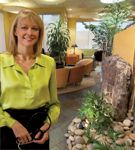Article
Form and function: Designing an office space that works
Is your office space performing at its best? Try experiencing it the way your patients do, through the waiting room.

Key Points

Then walk the halls. In the exam rooms, front desk, and business office, how easy is it to find the tools and equipment you need every day?
If you've noticed some things you would like to change, you have already taken the first step toward redesigning your office. You have started making a list of design issues to address.
DESIGN CAN OPTIMIZE PRACTICE FLOW, IMPROVE EFFICIENCY

"Our nurses' station is core central," says LifeScape co-owner Susan S. Wilder, MD, a family physician in Scottsdale, Arizona. "It's right in the middle. It's wide open. There's a lot of space and a lot of ability for doctors and medical assistants to communicate between patients. Doctors will be out there with their computers, so you can accomplish a lot in a short period of time."
The station contains what Wilder calls "tackle boxes" for acute wound care, eye care, and anaphylaxis. "It just makes it easy to grab and go and not have to be looking around for a tray," she says
Richard Haines Jr., an architect and president of Medical Design International in Norcross, Georgia, says that any redesign must address issues with poor traffic flow, chronic inaccessibility of supplies, and cramped workspace.
These improvements require not just a careful eye but also some thought and creativity, Haines says. You need to identify bottlenecks and their root causes, and come up with practical solutions.

As a general rule, consultants say that all supplies, equipment, and staff should come to you, rather than you going to them. "You work out the work flow so that you are not running all over the place," says Charles M. Kilo, MD, chief executive officer of the GreenField Group, a healthcare practice consulting and redesign firm in Portland, Oregon.
One question to ask, he says, is: "How many steps do you have to take?" In a doctor's office, staff members are always on the move, performing the same set of tasks again and again, so any reduction in the number of steps they take on each task will produce significant gains in efficiency.





